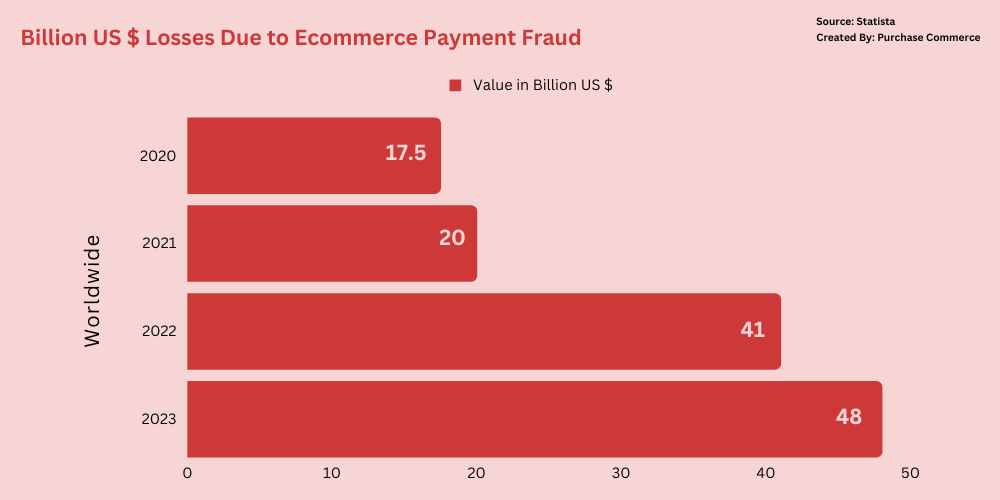12 Dimensions of Ecommerce Security: Secure Your Business & Customers
When it comes to ecommerce, the entire process revolves around the transmission of data between two or more parties online.
However, on the other hand, the internet is now undergoing security threats and cyber-attacks.

As per Statista, ecommerce losses were 41 billion US dollars due to ecommerce payment fraud in 2022, and it may reach 48 billion US dollars in 2023.
Recent research indicates that cybercrime is on the rise for some major companies like Equifax, Yahoo, Facebook, etc., which themselves consider a victim of cyber-attacks.
An ecommerce website must protect its assets from unauthorized access, use, alteration, or destruction. A secured ecommerce business should have a reliable infrastructure and framework.
Let's discuss this in detail.
What is ecommerce security?
Electronic Commerce or Ecommerce security protects online transactions and information between sellers and buyers from unauthorized access, theft, and alteration.
Ecommerce Security Threats
Here are some of the common security issues that may occur in your ecommerce business:
(1) Phishing
Phishing is a cyber-attack method involving collecting sensitive user information like login and credit card details by sending fraudulent emails or messages.
(2) Pharming
You may come across this issue a lot. It is the type of cyber attack where cybercriminals redirect users to fake websites identical to the original website to get user information.
(3) Whaling
Whaling, aka CEO fraud, is a type of Phishing attack where the target is high-level business executives like CEO to receive sensitive information like financial data.
Statista also states that phishing, pharming, and whaling are the most common fraud types experienced by sellers in 2022.
(4) Malware
To steal sensitive information, hackers may use malware, software created to exploit computer systems.
(5) SQL injection
SQL injection is a technical attack where cyber criminals inject malicious code into an ecommerce website database to get access to users' information.
(6) Distributed Denial of Services (DDoS) Attacks
DDoS attacks overload the websites' servers and lead to crashing. This can result in loss of sales and damage business reputation.
These threats can make considerable losses to ecommerce businesses. Yet you can protect your ecommerce website with the following solutions.
Ecommerce Security Measures
(1) Install SSL Certificates
SSL (Secure Sockets Layer) is a protocol that provides secure and encrypted communication between your ecommerce business website and the user's web browser.
By installing an SSL certificate to your website, all sensitive information of users is encrypted and protected from cyber-attacks.
With a padlock icon in the address bar, the user confirms the SSL installation on your website.
(2) Two-Factor Authentication
By now, we are using two-factor authentication in our Facebook, Instagram, Gmail, and other accounts.
Activate this two-factor authentication for your ecommerce website in addition to regular password login. This may act as an extra security layer to protect your business account.
(3) PCI Compliance
The Payment Card Industry Data Security Standard (PCI DSS) outlines security standards for handling credit card information. The e-commerce platform should be PCI compliant to ensure that your credit card details are being handled securely.
(4) Fraud Detection
Your eCommerce platform should have a fraud detection feature to identify suspicious transactions. By blocking unusual transactions or IP addresses, you can protect your website.
(5) Security Updates
Make sure that your ecommerce platform provides security updates to stay away from common threats.
By implementing these measures, you can secure your ecommerce website. Now we will dive into the actual topic (i.e.,) ecommerce security dimensions.
What are the dimensions of e commerce security?
Dimensions of e-commerce security refer to the different categories of ecommerce security that businesses need to consider to protect their website & customer information and ensure customer trust.
Look at the different dimensions of security.
12 Dimensions of Ecommerce Security
1. Integrity
We all have one common question, whether we have received the same data from the sender. Now it is the duty of integrity for the correctness of the information transmitted, received, or displayed on a website over the internet.
Integrity can ensure that information on the internet has not been altered in any way by an unauthorized party. It maintains the consistency, accuracy, and trustworthiness of the information over its entire life cycle.
Customer perspective on integrity: Is the information I have transmitted or received altered?
Merchant perspective on integrity:Is the information present on the website altered without authorization? Is the information received from the customer valid or not?
Example: The most common threat will be - Would any unauthorized person intercepts and redirects payment into a different account?; as ecommerce sites prefer online transfer mostly.
Let us consider a subscription model, where you will give credit card details for a bill payment to the merchant. If someone added extra cost to your credit card bill without both your or the merchant’s knowledge, then you need to pay extra money for something you haven't purchased.
2. Non-repudiation
Good business depends on both buyers and sellers. They must not deny any facts or rules once they accept that there should not be any repudiation.
Non-repudiation ensures that the sender of a message cannot deny having sent the message and that the receiver cannot deny having received the message.
In other words, it is an assurance that anyone cannot deny the validity of a transaction.
Most times, non-repudiation uses a digital signature for online transactions because no one can deny the authenticity of their signature on a document.
Customer perspective: Can a party take action on me if I have denied the action?
Merchant perspective: A customer can deny a product after ordering it.
Example: When a merchant does not have enough proof of customers who have ordered with them during a credit card payment transaction, the merchant cannot proceed further.
Sometimes customers claim that they haven't ordered the product from a particular merchant if they disliked the product later.
3. Authenticity
In ecommerce, since both the customer and seller need to trust each other, they must remain who they are in real life. Both the seller and buyer must provide proof of their original identity so that the ecommerce transaction can happen securely between them.
Every ecommerce site uses authenticity as a tool to ensure the identity of the person over the internet. In ecommerce, fraudulent identity, and authentication are also possible, which makes identity a difficult process.
Some common ways to ensure a person's identity are for customers to log in using a password.
Customer perspective: Who am I dealing with? Who can I assure the person I am dealing with is who they claim to be?
Merchant perspective: Is the customer that I am communicating with a real person? If not, what could be their identity?
Example: Some users can use a fake email address to access any of the ecommerce services.
4. Confidentiality
Confidentiality refers to protecting information from being accessed by an unauthorized person on the internet. In other words, only the people who are authorized can gain access to view or modify or use the sensitive data of any customer or merchant.
According to Juniper Research, nearly 146 billion records will be exposed by criminal data breaches between 2018 and 2023.
One confidentiality breach will be sniffing. It's a program that steals all the important files of the company, individual identity or email messages, or personal reports of the internet user.
Customer perspective: Can someone other than the intended recipient or a person read my message?
Merchant perspective: Has any unauthorized person accessed the information on my site without my knowledge?
Example: Ecommerce uses a username and password to log in to their account. Let’s consider this case for resetting the password, where an ecommerce site sends a one-time password to their customer via email or phone number if someone else reads it.
5. Privacy
Where confidentiality is a concern about the information present during communication, privacy concerns personal details. In general, privacy is used to control the usage of information by the customers that they have given to the merchant.
Canva faced data breaches in 2019 that included the attack on users' information like name, email address, and more. for 139 million users.
Privacy is a major threat to any online transaction or internet user since personal information has been revealed and there is no way back to disclose it.
Customer perspective: Can I control the usage of information about myself that I have transmitted to the ecommerce site?
Merchant perspective: What if anyone else uses personal data collected as part of the ecommerce transaction? Is there any unauthorized person to access a customer’s personal data?
Example: If a hacker breaks into the ecommerce site, they can gain access to the customer's credit card details or any other customer information. This also violates information confidentiality and personal privacy.
6. Availability
Continuous data availability is the key to providing a better customer experience in ecommerce. It increases online visibility, search engine rankings, and site traffic.
Data present on the website must be secure and available 24x7x 365 for the customer without downtime. Otherwise, gaining a competitive edge in the digital market will be difficult.
Customer perspective: Can I access the site at any time from anywhere?
Merchant perspective: Whether my site is operating without any downtime?
Example: An ecommerce website can be flooded with useless traffic that causes it to shut down your site, making it impossible for the user to access the site.
7. Risk Management
In ecommerce, the risk ever associates with the transaction.
Risk management involves identifying potential vulnerabilities and implementing measures to ensure a safe and trustworthy transaction between seller and buyer.
Fraudulent transactions are one common risks where someone uses fake credentials to shop for an item. By using fraud detection features, merchants can identify fraud threats and avoid the risk.
Customer perspective: Is my personal information and payment data protected from potential security breaches?
Merchant perspective: Am I identifying potential threats and implementing measures to eliminate risks?
Example: Two-factor authentication is one of the best ways to reduce the risk of unauthorized access.
For this step, users should provide a second login authentication by confirming OTP sent to their email or mobile number other than a password.
8. Application Security
Security should be the main factor when designing ecommerce apps or websites as they handle personal data and payment details. App security involves the practice of protecting ecommerce platforms and users from data breaches that arise due to ecommerce apps.
Developers should take responsibility for secure coding practices, vulnerability scanning, and penetration testing to identify and eliminate security risks.
Customer perspective: Is my personal and payment data protected from application-based threats like malware or hacking?
Merchant perspective: Are our applications and software used in ecommerce operations protected from security threats?
Example: An ecommerce platform may conduct regular penetration testing to identify and eliminate potential security risks in its applications and software. It helps to know that the platform remains secure and protects user data from potential threats.
9. Physical Security
As an overlooked aspect of ecommerce security, Physical security involves securing the physical infrastructure of ecommerce operations, such as servers, data centers, and other facilities.
Ensuring the physical security of data centers and servers hosting ecommerce websites is crucial.
Physical security measures include access controls, surveillance cameras, and backup power supplies, to ensure that the data center remains secure and operational at all times.
Customer perspective: Is my personal and payment data protected from physical theft or damage?
Merchant perspective: Are our servers and other physical infrastructure protected from theft, damage, or other physical threats?
Example: An ecommerce platform may use a secure data center that requires biometric authentication and 24/7 surveillance to protect the physical infrastructure that supports the platform.
10. Network Security
The network is a vital component of ecommerce security. With network security, an ecommerce website is protected from vulnerabilities caused due to network traffic.
For securing personal data and payment details, websites should have strong and secured network security protocols such as firewalls, encryption, and intrusion detection systems. It prevents sensitive information from unauthorized access.
Customer perspective: Is my personal and payment data protected from unauthorized access during transmission over the network?
Merchant perspective: Is our network protected from unauthorized access or other network-based threats?
Example: An ecommerce platform may use encryption to protect user data during transmission over the network.
11. Compliance
As like in real life, ecommerce transactions have to follow certain rules and regulations to ensure the privacy of both sellers and buyers.
Compliance involves adhering to legal requirements related to data privacy. It ensures that the ecommerce platform operates within the regulations and protects customer information.
Customer perspective: Is my personal information protected and used according to data privacy laws?
Merchant perspective: Are we complying with legal and regulatory requirements related to ecommerce operations? Are we protecting customer data and privacy?
Example: An ecommerce platform that operates in Europe must comply with the General Data Protection Regulation (GDPR) and other data privacy laws.
This means that the platform must obtain user consent before collecting and processing personal data, provide users with access to their data, and ensure that the data is stored securely.
12. Authorization
With authorization, a website can ensure that only authorized persons can access sensitive information like the payment process.
It is about granting access to specific resources based on user identity.
As with other businesses, authorization is critical to identify user identity in ecommerce business transactions.
Customer perspective: Am I authorized to access the information or perform the action I am trying to do on the website?
Merchant perspective: Are users who access our website authorized to do so? Are they allowed to perform particular actions on our website?
Example: Suppose a customer tries to purchase using a credit card that is not theirs. The authorization process should detect that the customer is not the card owner and deny them access to the payment gateway.
It prevents fraudulent purchases and protects the customer and the merchant from financial losses.
Summary of 12 ecommerce security dimensions

Secure Your Ecommerce Website
The above-discussed factors are the most common dimensions of ecommerce security that all ecommerce entrepreneurs must deal with as part of a growing online market.
Cyber-attacks often happen that may affect anybody, but as an ecommerce business owner, you should not let your customers become victims of hacking or other attacks.
So, as a merchant, make sure you prioritize ecommerce security. Together, we can make online transactions safe and secure for everyone.
As an ecommerce platform, we (Purchase Commerce) are committed to providing a secure environment for your online store.








